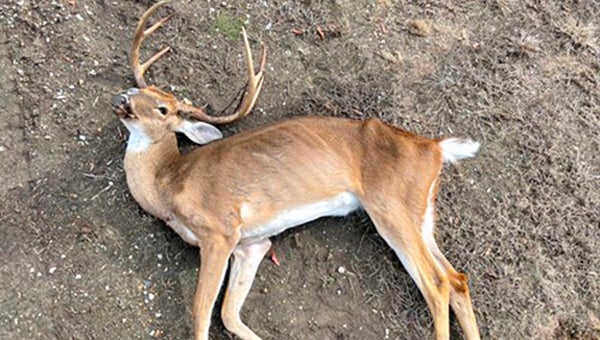Claiborne County added to CWD management zone; Sharkey County removed
Published 1:32 pm Friday, July 1, 2022

- This deer suspected of having Chronic Wasting Disease was found in Warren County in December 2021. (Photo courtesy of the Mississippi Department of Wildlife, Parks and Fisheries)
By Hunter Cloud
Brookhaven Daily Leader
SARDIS — Four new counties, including Claiborne County, were added to the Chronic Wasting Disease management zone by the Mississippi Department of Wildlife, Fisheries, and Parks at its June meeting.
Russ Walsh, chief of wildlife with the MDWFP, said positives detected within 10 miles of Claiborne, Tishomingo, Prentiss and Lafayette Counties moved them into CWD Management Zones.
Claiborne, south of Warren County, was moved into the zone not because of the two positives found near the border of Issaquena County this year but because of a positive case in Tensas Parish in Louisiana.
Louisiana’s first positive case of CWD in Tensas Parish was detected one mile from Davis Island in Claiborne County. This stretch of Mississippi soil was on the left side of the river and is six miles from the right bank of the Mississippi River.
Being placed in a management zone means landowners and hunters in Claiborne County can not have mineral sites such as salt licks or supplemental feeders. There is also a ban on carcass transportation.
“There is no elimination of Chronic Wasting Disease, so we have to mitigate the disease,” Walsh said. “This plan is what other states have done. Warren and Issaquena County are nearby, and they have had a positive. One buck we tagged with a radio collar in Issaquena crossed the river and traveled 18 miles, and a doe traveled 22 miles.”
CWD Positive deer could swim across the Mississippi River from Louisiana to Mississippi or vice versa and spread the disease. Louisiana placed Franklin, Madison and Tensas parishes in both a feeding and carcass export ban in their reaction to the first CWD case.
There were some questions about food plots and the difference between having them and a feeder. Walsh told the commission a supplemental feeding ban does not prevent deer from spreading CWD. It does limit the concentration of deer in an area.
“Deer who are eating in a beanfield aren’t eating in the same place every night, but with a feeder, they are eating in a 20-foot radius,” Walsh said.
District 1 Commissioner Bill F. Cossar proposed an amendment to the commission’s CWD management plan to provide an exit plan for counties in the management zones. His amendment would move counties out of the zone if they go three years without a detected positive.
“Right now we have no exit ramp for these counties in the management zones,” Cossar said.
His amendment passed 4-1 and is effective immediately. Some counties in the management zone may move out because they haven’t had a positive in three years or have not had one within 10 miles of the county line for three years. MDWFP released a map of the new management zones on Friday.
In the Issaquena Management Zone, Claiborne County was added and Sharkey County was removed. In the North Mississippi Management Zone, Lafayette, Prentiss, and Tishomingo were added and LeFlore, Pontotoc, and Tallahatchie were removed.
The Issaquena Management Zone also includes all of Warren and Issaquena counties.
Chronic Wasting Disease is a disease in white-tailed deer, elk, and mule deer. CWD is caused by a contagious prion. For some deer, it could take a year or more to develop symptoms. Those symptoms are drastic weight loss (wasting), stumbling, listlessness, and other neurological symptoms. Infected animals shed prions through saliva, feces, blood, and urine.
Other deer can become infected through direct contact with an infected animal and indirect contact from an infected environment. Once the disease occurs in an area, evidence demonstrates eradication is unlikely.
At this time, there is no evidence that suggests CWD poses any risk to humans. However, hunters are advised to not consume any meat from a CWD positive deer.





